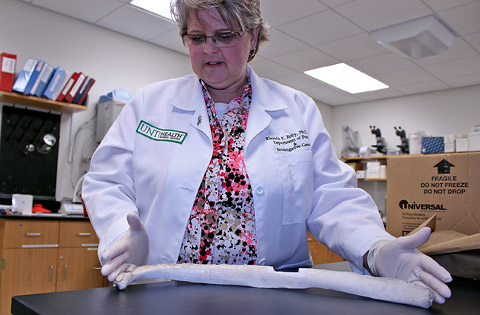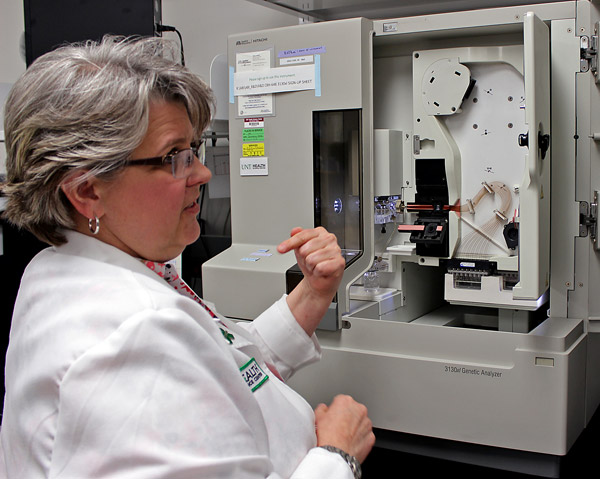Finding lost souls is in this scientist's DNA
One of the world's leading forensic experts was born under the stairs in an unassuming home in Oklahoma City. In the kitchen pantry, past the preserves and canned goods, a Hobbit-sized door hid Dr. Rhonda Roby's first laboratory. The young scientist loved how her parents couldn't (or wouldn't) squeeze in the small space — a place solely hers where she nurtured her fascination with science.
"First of all, you don't carpet a laboratory, right? So the first thing I did was I carpeted my laboratory," Roby recalls. "I got two cinderblocks, and then just a piece of wood, just a plank, and that was my lab. I got a microscope eventually, and a lamp in there, and that was my space…. I have very fond memories of those days."
By the time Roby learned of the Camp Scott murders in northeastern Oklahoma in 1977, she was in junior high school — quickly outgrowing her hidden lab. Three young girl scouts were abducted and murdered at their summer camp. Roby watched the case closely, even writing to one of the forensic scientists and visiting her lab. Roby was hooked.
When she was in graduate school at the University of California, Berkeley, Roby began working with mitochondrial DNA. This genetic blueprint is passed down maternally and is far more abundant than nuclear DNA, which comes from both the mother and father. Better still, mitochondrial DNA spans generations, making associations (Roby doesn't use the term "identification") from skeletal remains possible. Of course, using mitochondrial DNA to identify victims didn't exist until Roby and her colleagues mastered the laborious process. To Roby, the possibilities were irresistible.

samples. The lab never displays human bones — this is a cow rib.
(Credit: Charles Brown)
"If we have an old skeletal remain that's been out in the environment for many years, and it's been exposed to the extreme heat that you get here in the state of Texas or in other deserts, the DNA starts to degrade from the heat, from the environment, from whatever kind of exposure — acid from the soils. All of that combined, maybe we can't get nuclear DNA out of that, but we can get mitochondrial DNA," Roby says. "With nuclear DNA, we typically want to get close relatives because you inherit half from your mom, so that's going to start being diluted out after many generations. However, with mitochondrial DNA, we can test your mother. Your biological siblings would have the same mitochondrial DNA. If your biological mother has a brother, so your maternal uncle, he will have the same mitochondrial DNA as you. Or a maternal aunt. And if that aunt had a daughter that had children…. So we can go back as long as it's through that maternal line."
Roby spent the bulk of her career using her knowledge of mitochondrial DNA to establish herself at the forefront of victim identification. She worked to uncover the names of those murdered by the Green River killer; a corpse found under John Wayne Gacy's house; soldiers from World War II, the Korean War, and other conflicts; airline crash victims; Branch Davidians; Tsar Nicholas II and the Romanov family; and those who perished at the World Trade Center on September 11, 2001 — perhaps the pinnacle of her still-evolving career. Today she is an associate professor and projects coordinator for forensics and investigative genetics at the University of North Texas Health Science Center in Fort Worth, Texas.
The work is long, tedious, and difficult — all victims have their mitochondrial DNA sequenced and entered into a database that is then cross-referenced with a database of the family members of missing people. Getting those people to submit to the process is critical; it's the only way victims can be matched and, therefore, identified. But Roby is fueled by those positive IDs — bringing peace and closure to the families of those lost.
As Seen on TV
You probably think Dr. Roby rolls her eyes at the never-ending string of crime dramas — "Bones," "CSI," "SVU," "NCIS," "Castle," and so on. Actually, no. She even watches a few of them.
"I watch 'SVU,'" she admits. "I don't watch 'NCIS,' but a lot of my friends do, and they'll call me. 'Did you see that?' or 'Can you tell me?' But it's been great for the field. There's been some very positive things and some negative things. One positive thing: When I'm chatting with someone next to me on the airplane and I say I'm a forensic scientist, I no longer have to tell anyone what that is…. I think it's attracted a lot of young people to the field, which is great."
That doesn't mean the shows don't perpetuate unreasonable expectations. Nothing happens as quickly in the real world, and the teams tackling these cases are made up of dozens of people, not five.
"People think we do everything," she laments. "What I think it shows when they show one actor doing all that stuff, the bottom line is that we have to work as a team. None of these cases can be done without teamwork. I think that's the neat thing about our field…. The other thing is they think the results come out very quickly. And our laboratory lights are not blue; don't have blue lights anywhere. And I'm not the sexy DNA analysts that they have on TV, unfortunately, but we have some very good-looking DNA analysts. I should introduce you to them."
"I think it's important for the scientists to be able to go out there and meet the family members," she says. "One of the things I was part of with the Department of Defense is we had the opportunity to sit at a dining room table in a family's home and explain why we believe that these remains were those of their father, or their son, or whoever. And those people have waited for years, decades, to find their loved one. They want their loved one home…. Most of them have come to understand that their loved one is not living any longer…. We have great, great conversations. They pull out pictures and old clothing, and they've told me about their families. They'll share how they met their loved one. I've had them throw their arms around me and just thank me, and I've had them invite me to the burial ceremony once they actually have it. It's an experience I can't, I would not trade it for the world."
The phone woke her up around 6 a.m. on 9/11. Roby had no intention of getting up that early, but her mother was on the other end, telling her to turn on the television. Roby, like so many people, woke up to the nightmare unfolding in the United States. Later, she sat in a management training class, her phone ringing constantly with people seeking help. When the instructor told the class to silence their phones, she said that was impossible and left.
The next day, Roby and a handful of colleagues were on a private plane waiting to take off from Oakland, Calif., bound for New York City. It was one of the few planes FEMA granted permission to fly the day after the attacks. It was originally scheduled to leave from San Francisco International Airport, but an unknown person was shooting wildly around the airport, so they altered their flight plans.
"They gave me this really nice seat on this jet. It was a beautiful jet," she says. "They gave me kind of this bucket seat. There weren't that many of them. There were like these lined chairs and they let me sit there. I was kind of sitting by myself, and I think I was just trying to figure out and wrap my head around what all we'd end up having to do."
Roby had collected specimens for hundreds of victims of airplane crashes in the past, but she was told to plan for 15,000 dead and hundreds of thousands of samples. It was overwhelming, but Roby was determined to lead the efforts to identify the missing.
Once she landed, Roby was whisked away to Ground Zero almost immediately. She was dressed in a business suit, and chaos reigned as cops, medics, and firefighters moved like ants amongst the burning rubble. She tried to make sense of what she was seeing and organize a procedure—there was no way to secure this crime scene, she thought. And then everything stopped.
"They pulled out a firefighter who had died, and there's a procedure when they find a first responder," she says, fresh tears coming to her eyes nearly 13 years later. "Everything pretty much stopped. They carried him out — you could just see this firefighter uniform and the helmet — and everything just kind of stops. There's all this chaos all going on around you — I've never talked about this — there's all this chaos, the wind is blowing, papers flying around. So there's all this stuff going on around you, going a million miles a minute, and they carry out this firefighter, and when you're in the center of that everything right there stopped. It's like a whirlwind going around you. I don't know how to explain that.

tedious, hands-on process.
(Credit: Charles Brown)
"All the first responders, everybody who was there helping to clean up or trying to go through everything, they all stopped. They all saluted. I stopped, and I didn't know what to do, so I copied them. I didn't know what else to do — I didn't know if that was right; I didn't know if it was wrong. I never really knew if that was the right thing to do, but it's what I did."
Roby quit her job in California and spent the next three years on contract working from Rockville, Md., for the city of New York, leading the efforts to identify remains, work that continues to this day.
These days, Roby oversees a new crop of forensic scientists who work feverishly to identify a seemingly unending line of victims. Roby herself is still working with mitochondrial DNA as it relates to Alzheimer's, prostate cancer, and other diseases. She hopes her research will eventually find the genetic markers indicating a person is at risk to develop these illnesses — another weapon in the fight.
But her heart is never far from the victims her lab strives to help. And every time they find a match, every time a family finds peace, Roby's pioneering work is validated. "If we can get a loved one back to a family member, that is my chase. That is my passion," she says. "If I can get one family member, one loved one back to someone — how can you put a dollar figure to that? I don't know how to do that."
